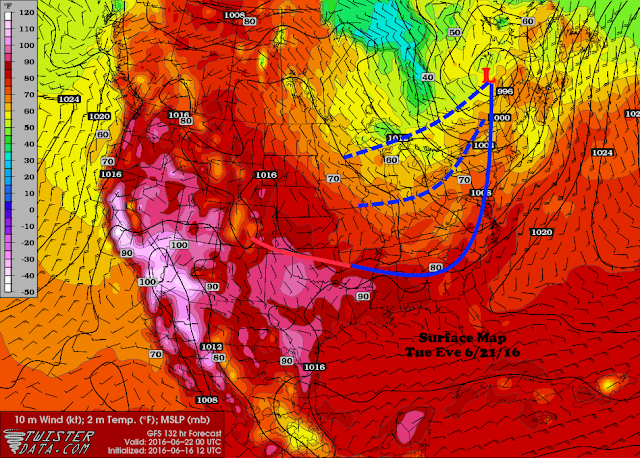Looking Back At Spring - A Wild Ride!
No one has to be told what a changeable and variable spring we encountered across Southeast Lower Michigan. While temperatures averaged slightly above normal; getting there was certainly not a direct road. First half of March started out on the cold side only to warm up big-time later giving us a preview to mid-late spring's typical weather. By month's end; temperatures averaged around 6 1/2 degrees above normal! Meanwhile, rain and even snowfall despite the warmth was plentiful; a couple inches above normal as a whole. The first half of April did an about-face in the temperature department with a cold snap leading to temperatures averaging 5 to 7 degrees below normal (just the opposite of March). The rest of the month moderated some but still, April averaged a degree to three below normal depending on location. Precipitation amounts slacken off a bit in April with most areas seeing slightly below rainfall but normal to above snowfall due to the cold. May weather was all over the board; especially the second half with near record or record cold giving way to near record heat. As the heat increased, the rains decreased - not a good thing for the growing season nor the approach of June and Summer. A somewhat rare bird of sorts was seen in mid May with the cold bringing scattered pockets of snow and sleet (or graupel) on the 14th and/or 15th; setting snow records for occurrence on those particular dates. Latest snow observed around the region in May has been the 31st, fortunately this was not challenged this year. And speaking of a challenge...
Currently
A rapidly changing ENSO pattern is quite evident in not only current data but projected data for the summer into the fall. El Nino has just about died a quick death and we are entering Neutral conditions for the summer, see current SST's broken down weekly for May 2016 (Chart -1) and model projections below that (Chart -2). Neutral SST's indicate really no influence from the Pacific for the summer into the early fall, anyway. This only heightens the complexity for an Outlook since summer typically has a weaker upper wind pattern pattern to start with, then add to this, a Neutral ENSO pattern, little in the way of patterns
Recently; the present pattern still has some of the "El Nino lag" with the southern jet quite active across the southern Plains and less further east and north. Meanwhile; the influence of the semi-stationary Polar vortex over northern into eastern Canada has been absent over the Great lakes during the latter half of May (Chart - 3, May 500 MB). This has lead to very warm conditions /near record at times/ with no substantial rains. Some areas have seen next to nothing to speak of since mid May.
Summer 2016 - Where Do We Go From Here?
With the spring
pattern all over the place; investigating the true trend of our recently
past weather is difficult. Therefore; are there any patterns seen in
the analogues that may match up with the current local and hemispheric
pattern? Analogues below indicate a relatively normal summer as far as temperatures (within a degree or so) but with above normal rainfall; certainly contrary to the recent pattern, but not unlike our earlier spring pattern - what to do?
First off as far as Temperatures:
Recent variability but trends toward normal to above normal gives us a little more weighting to at least normal temperatures (the most predominant in the analogues) and against the three below normal summers displayed. On the flip side; I must mention, no where did I come up with a hot summer talked about in some media venues. Hot summer meaning placing in the top 10 warmest summers. As a matter of fact with the possibility of a cooler June (or at least dominated in the
trend displayed strongly by the analogues) an outlook for a normal summer is more suitable.
Our best analogues this past winter, 1982-83 and 1997-98 contained normal summer temperatures averaging very close to 72; just a few tenths different from each other. Likewise; I look for the summer to continue to display the more roller-coaster type of temperature pattern (not unlike seen this spring and also dominated, the Spring of '83) with sometimes significantly above, below and everything in-between but ultimately resulting in the normal or typical summer.
Summarizing: I look for temperatures to average 1 - 2 degrees of the summer norms across Southeast Lower Michigan.
Rainfall:
Recent rainfall trends in late May certainly
contradict the dominant analogues for the summer with a preference for
above normal rainfall. Out of the limited seven analogues, five were
wetter than average (and inch or better above normal), one normal
(within an inch of normal) and one below average (an inch or more below
average).
There was quite a range of totals from as little as 5 inches way back in 1889 to just over 15 inches even further back in 1878. More recently however, over 12 and a half inches /12.60"/ was measured during our waning period of the last very strong El Nino in 1998.
Comparing the two best analogues of the winter at Detroit; 1982-83 and 1997-98; 1983 was a better analogue for temperature trend of the winter but was drier during the winter; then became wetter that spring and summer. The Winter into Spring of '98 was somewhat more uniform in precipitation amounts and pattern. Both analogue summers turned out wet (over far Southeast Lower Michigan around Metro Detroit). Ironically; both also contained above normal precipitation amounts of 11 to 12 1/2 compared to a normal of just under 10 inches /9.89/.
However; researching further north in Southeast Lower Michigan gives a different account of rainfall distribution (though Flint and Saginaw analogues not shown for the summer, rainfall is below). Drier conditions prevailed further north from the Flint and Saginaw area into the Thumb region both in 1983 and 1998, particularly in the Summer of '83, when all areas in Southeast Lower Michigan saw a dry August. The one trend that continued was the variability of rainfall amounts and summer distribution. Analogues strongly suggest at drier and wetter regions over Southeast Michigan for the summer with the more likely the drier areas, further north.
In conclusion: Look for rainfall to average normal to above across the southern half of Southeast Lower Michigan and normal to below across the northern half.
Another interesting item noted was both summers were fairly busy with thunderstorms and logically as one might think; more occurred where the higher rainfall totals were over the southern areas, or south of I-69. Just as an example on how skewed summer rainfall amounts can be with convective rains; most of the 4.24" of rain of July's 5.72" total at Detroit in 1998 fell in one thunderstorm complex on 7th. Now, this doesn't necessarily mean it will happen exactly like that again this summer as far as rainfall amounts and distribution but an item to keep in mind.
Detroit
1983 June July August
1998
Monthly Rainfall Flint|Saginaw for Summer's of '83 and '98
1983
June July August
| 3.94 | 2.06 |
2.24 | 1.66 |
2.26 | 2.32 |
|
1998
June July August
| 1.25 | 1.81 |
1.13 | 1.30 |
2.62 | 1.51 |
Severe Weather
Later analogues that contain data; 1973, 1983 and 1998 all had their abundance of storms and occasional severe weather during the summer. Severe weather, thus far through the spring season has been almost absent; so any increase would be notable. Most storm activity occurred when we generally peak, mid June to mid July. Another second peak was noted mid July thru August.
What does our finest season model /CFV2/ project for the Summer?
Temps:
Rainfall:
Basically; it looks very similar to the researched and chosen analogues this time around. Temperatures near normal and precipitation normal to above. Even detecting a "shading" or possibility of higher rainfall across the southern portion of Southeast Lower Michigan.
Whittling it down further by month (JJA - click on the maps for better resolution).
Temp Precip
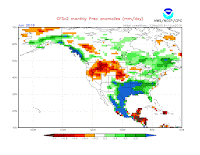
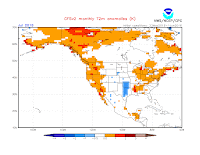
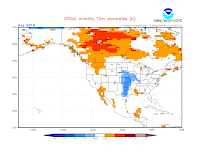
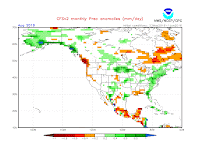
Have a great summer and try to enjoy the weather when able because before you know it; winter will be just around the corner. Thus far, a La Nina Winter is expected at that; hmmm.
Making weather fun while we all learn,
Bill Deedler -SEMI_WeatherHistorian











